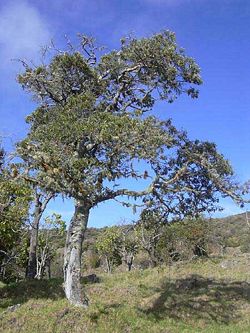Rhamnaceae
Read about Rhamnaceae in the Standard Cyclopedia of Horticulture
|
|---|
|
Rhamnaceae from the genus Rhamnus,the old Greek name). Buckthorn Family. Fig. 36. Trees or shrubs, rarely herbs, sometimes spiny or climbing: leaves simple, mostly alternate: flowers bisexual or unisexual, regular, perigynous, small, greenish, mostly axillary; sepals 5, rarely 4, valvate; petals 5, or 4, alternate with the sepals; stamens of the same number as the petals and opposite them; an intrastaminal disk lining the cup-shaped receptacle; ovary 2-4-celled, superior or inferior; cells 1-, rarely 2-, ovuled; styles 2-4, more or less connate: fruit drupaceous, or winged, or capsular. Rhamnaceae has 46 genera and about 550 species very generally distributed over the earth. Rhamnus is the largest genus (70 species), and the most widely distributed. The family is represented by 6 native species in northeastern North America. It is most closely related to the Vitaceae and Celastraceae, differing from the former in the simple entire leaves and strongly perigynous flowers, and from the latter in the stamens being opposite the petals. The family is not of great economic importance. The berries and bark of Rhamnus cathartica (buckthorn) contain a bitter principle which is purgative. The fruits of some species of Rhamnus yield yellow or green dyes of some importance R. dahurica and R. tinctoria give Chinese green. The bark of R. cathartica and R. Frangula (Europe) is used to dye yellow. R. Purshiana (California) is the cascara segrada of medicine, a strong purgative. The fruits of Zizyphus Lotus are pulpy and agreeable, and were much prized by the ancients. The fruits of several species of Zizyphus are eaten in various parts of the Old World. The spiny branches of Paliurus Spina-Christi or Zizyphus Spina-Chrisli are thought to have been those from which the crown of thorns was made. Nine or more genera are in cultivation in N. America for ornamental purposes. These are: Ceanothus (New Jersey Tea); Berchemia (Supple Jack); Gouania; Hovenia; Paliurus; Pomaderris; Reynosia; Rhamnus (Buckthorn); Zizyphus (Jujube).
|
| Buckthorn family | ||||||||||
|---|---|---|---|---|---|---|---|---|---|---|
 Hawaii kauilatree (Alphitonia ponderosa) | ||||||||||
| Plant Info | ||||||||||
|
| ||||||||||
| Scientific classification | ||||||||||
| ||||||||||
| Genera | ||||||||||
| See text. |
Rhamnaceae, the Buckthorn family, is a large family of flowering plants, mostly trees, shrubs and some vines.
The family contains 50-55 genera and approximately 870-900 species. The Rhamnaceae have a worldwide distribution, but are more common in the subtropical and tropical regions. The earliest fossil evidence of Rhamnaceae is from the Eocene.
The simple leaves can be either alternate and spiraling, or opposite. Stipules are present. These leaves are modified into spines in many genera, in some (e.g. Paliurus spina-christi and Colletia cruciata) spectacularly so. Colletia stands out by having two axillary buds instead of one, one developing into a thorn, the other one into a shoot.
The flowers are radially symmetrical. There are 5 (sometimes 4) separate sepals and 5 (sometimes 4 or none) separate petals. The petals may be white, yellowish, greenish, pink or blue, and are small and inconspicuous in most genera, though in some (e.g. Ceanothus) the dense clusters of flowers are conspicuous. The 5 or 4 stamens are isomerous with the petals (i.e. one stamen opposite each petal). The ovary is superior, with 2 or 3 ovules (or one by abortion)
The fruits are mostly berries, fleshy drupes or nuts. Some are adapted to wind carriage, but most are dispersed by mammals and birds. Chinese jujube is the fruit of the jujube tree (Ziziphus zizyphus) and is a major fruit in China.
The American genus Ceanothus, which has several showy ornamental species, has nitrogen-fixing root nodules.
Economic uses of the Rhamnaceae are chiefly as ornamental plants and as the source of many brilliant green and yellow dyes. The wood of Rhamnus was also the most favoured species to make charcoal for use in gunpowder before the development of modern propellants.
Genera
- Tribe Bathiorhamneae
- Tribe Doerpfeldieae
- Tribe Maesopsideae
- Tribe Paliurieae
- Hovenia – Raisin Tree
- Paliurus – Christ's Thorn
- Ziziphus – Jujube, Buffalo-thorn
- Tribe Rhamneae
- Auerodendron
- Berchemia – Bird plum, Red Ivory
- Berchemiella
- Chaydaia
- Condalia - Bluewood
- Frangula
- Karwinskia
- Krugiodendron
- Reynosia
- Rhamnella
- Rhamnus – Buckthorn
- Sageretia
- Scutia – Cat-thorn
- Tribe Ventilagineae
References
- Germplasm Resources Information Network - (GRIN) [Online Database]. "Rhamnaceae" (06 December 2006) [1]
